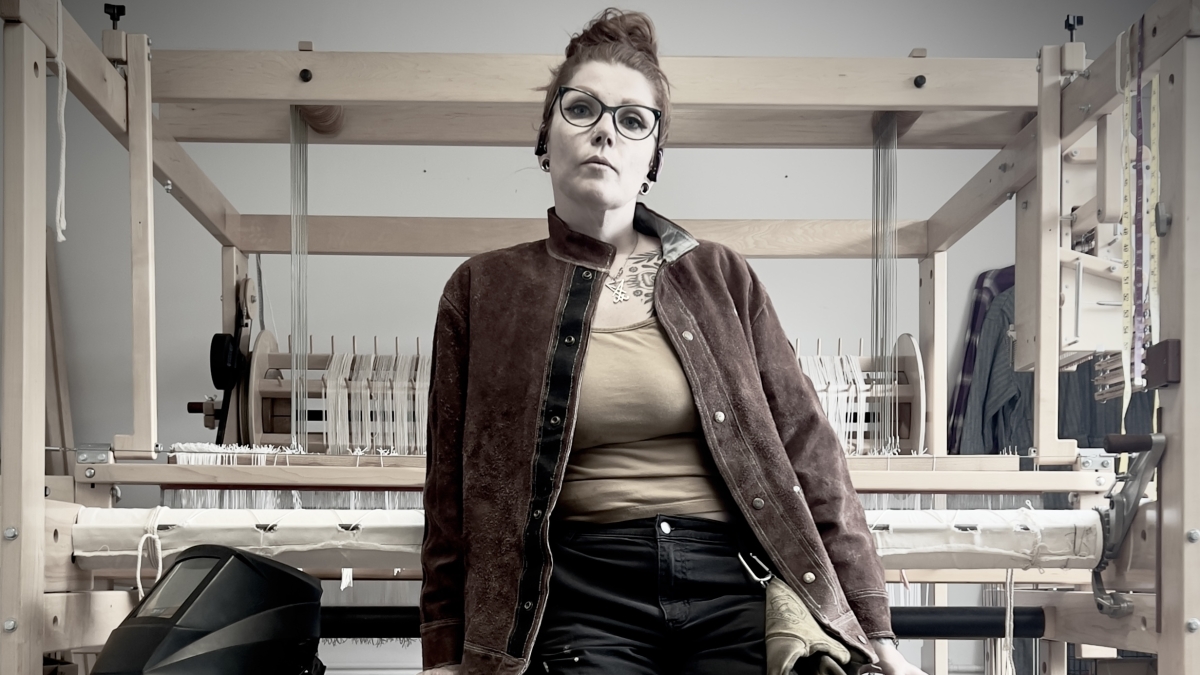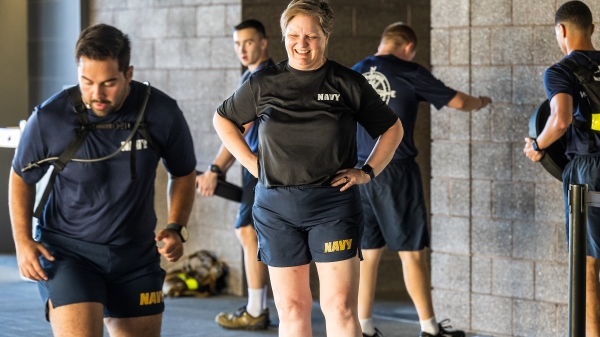Art history graduate student: ‘Here at ASU, I learned just how capable I am’

Sarah “Gigi” Brazeal is graduating with BA in art history and a minor in anthropology.
Editor’s note: This story is part of a series of profiles of notable spring 2024 graduates.
Sarah “Gigi” Brazeal never thought she would get a college degree from a four-year university.
“Higher education has never been something I felt I could attain,” she said, “nor did I feel like someone from my economic background had a chance of succeeding here.”
Brazeal, who graduated high school in 2001, said her experiences in high school and her economic situation initially kept her from fully pursuing her academic dreams.
“I was not encouraged by my high school academic advisor and was even told that higher education wasn’t for ‘people like me,’” she said. “I was not popular with the administration, as I was quite a little revolutionary and battled them with regard to student rights and the lack of inclusion for students of non-traditional faiths or LGBTQIA+ students. Though steadfast in what I thought was right for us, the students, I was still a child who took it to heart when I was told I wasn’t good enough for the university setting.”
She said after that experience, she didn’t try that hard in school, especially because she knew her single mother could not afford to send her to college.
But now, 23 years later, she is finally earning her BA in art history from the School of Art in the Herberger Institute for Design and the Arts and a minor in anthropology from School of Human Evolution and Social Change in The College.
“Here at ASU, I learned just how capable I am,” Brazeal said.
Despite her doubts about college, after high school she tried to pursue her academic dreams by attending community college, but after a year she said she ended up burning out and leaving.
Brazeal then pursued professional acting and was a traveling performer with the Renaissance Festival for many years. During that time, she returned to the community college system multiple times to finish her AA in her free time. In 2009, she landed a position with Microsoft Corporation and applied to ASU with the intention of earning her BA.
“However, I had a boss who was wholly unhappy with the thought of me advancing my education and leaving the company,” she said. “He made it impossible for me to attend, denying my tuition reimbursement requests and insisting I was needed during times when classes I needed were being offered. Again, I gave up.”
She left Microsoft to pursue a career in art.
“I have always been an artist,” Brazeal said. “Before ASU, I worked mainly in pen and ink, charcoal and skin. I found that tattooing was a very lucrative way to have a career centered on art.”
“Unfortunately, COVID made it very hard to work, since tattooing is very much not essential,” she said. “But, I finally had the time and zero obstacles to my education, and I returned to ASU.”
She said the scholarships and funding she received also enabled her to achieve success.
“It literally means everything. I would not be where I am today without these scholarships, and I certainly wouldn’t be able to spend so much time on my artistic practice of archaeological research,” she said.
Some of the scholarships she received include Osher Reentry Program Scholarship, the Osher Lifelong Learning Institute at ASU Intergenerational Learning Service Scholarship, the Seymore Rosen Studio Art Scholarship, the Windgate Foundation Studio Art Scholarship, the School of Art Special Talent Award – Studio Art and the Jack Breckenridge Art History Scholarship. She also works as a communications specialist with the School of Art.
After she graduates from ASU this spring, Brazeal plans to complete her MA in art history at ASU and then pursue a PhD.
“I plan to study the long global history and visual culture of ritual, religion and occult symbolism throughout time and civilizations,” she said. “It is my ultimate hope that I can become a university educator who uses my research and fieldwork to educate new generations of young people. I feel very much that I want to work at a public university and return to the system what I have gotten out of it here.
“Through my studies and the numerous connections with fellow students, staff and faculty, I learned that literally anything is possible to achieve as long as you believe it is.”
Question: What was your “aha” moment when you realized you wanted to study the field you majored in?
Answer: I had always wanted to pursue a degree in art, but when I started taking art history courses, specifically those on ancient art, I realized just how deep my love of ancient art and culture goes. After taking Dr. Nancy Serwint’s course on ancient Egypt, I added my BA in art history and a minor in anthropology.
Q: Why did you choose ASU?
A: As a nontraditional, returning student, it’s more like ASU chose me! I live in Phoenix, so it was the most logical choice. However, I am very thankful for ASU’s policy of inclusive excellence and its commitment to accessibility rather than exclusivity.
Q: Which professor taught you the most important lesson while at ASU?
A: This may be an impossible question to answer since there wasn’t just one.
Dr. Nancy Serwint helped me realize my academic aspirations and guided me to a fulfilling academic career in art and archaeology.
Dr. Betsy Fahlman helped me hone my writing skills and develop a voice in my writing that has served me well in my research and will continue to drive me forward in my academic career.
melissa button taught me that I do belong here and that I can achieve anything I want; it just takes the right attitude and a little hard work.
Both Hilary Harp and Dean Reynolds challenged me to grow as an artist. They have a way of lighting a fire under me that has forced me to grow by leaps and bounds in my artistic practice.
Erika Lynn Hanson introduced me to an entirely new 3D medium that I would never have tried on my own, and now I can’t imagine my life without it!
Dr. Matthew Kroot and Dr. Brenda Baker, both from the School of Human Evolution and Social Change, took a chance on an art student, let me into their classes and labs, and taught me how my artistic skills are needed and necessary in the fields of anthropology and archaeology.
Everyone I have met here has affected me to the point that I feel as though my success has been an amalgamation of the support and experiences I have had here at ASU. It really does take a village!
Q: What’s the best piece of advice you’d give to those still in school?
A: Never stop asking questions, and never stop pursuing what you want. Cold email people, ask every professor every question you have and never give up. Everyone here really wants you to succeed, and all you have to do is ask for what you want. If you have the drive to succeed, your professors will set you on the right path. But they cannot do that if they don’t know what you want. There’s a way to get where you want to go; you just have to be diligent about finding that way. Leverage your relationships, and make sure to take every opportunity you can to give back to those around you. This is a generative environment where one receives guidance and knowledge, which inevitably makes you the knowledgeable one that people will one day rely on.
Q: What was your favorite place on campus, whether for studying, meeting friends, or just thinking about life? (For online students: What was your favorite spot for power studying?)
A: The studio. There’s nowhere I’d rather be than welding steel or weaving fiber into an abstract representation of what my current academic studies are focused on. It is a special thing to be able to translate my art history and archeological work into works of art that others may enjoy while simultaneously giving me a unique way to express my ideas and passions in metal and fiber.
Now I work mostly in steel and textile, but I still make plenty of ink, charcoal and graphite work —plus the odd tattoo on a friend here and there. I currently have an ink piece at Northlight Gallery and will be installing a textile/steel sculpture in the upcoming show at Gallery 100 at the end of the month.
I also do a fair share of archaeological illustration for both archaeological projects I work on, which consists of pen and ink and digital work.
Q: If someone gave you $40 million to solve one problem on our planet, what would you tackle?
A: I’m not sure that $40 million would do it, but I would try to make sure that those who don’t come from privileged backgrounds could have more access and opportunity. Education is sorely lacking in this country, and the path to a university education is sadly not something many have. I would do what I could to ensure that students like me knew there was a way to higher education and that they do belong here. I never thought I would be here, preparing for graduation and discussing plans for a future PhD program. I want every person who grew up like me and felt defeated before they even started to know and have access to what I have here at ASU. Perhaps I could use this hypothetical money to create an endowment that ensures those from lower economic backgrounds can and will achieve their academic aspirations.
More Sun Devil community

A decorated life: Navy ROTC professor demonstrates leadership excellence
Katrina Hill has received just about every type of military and academic accolade there is and has demonstrated leadership capabilities throughout her time in the service.A Harvard and MIT Fellow. A…

2024 Tillman Scholar supports veterans by mitigating financial insecurity
Jack Schannep grew up in Tucson, Arizona, inspired by his grandfather's stories about serving in the military."My great-grandfather, a United States Military Academy (West Point) graduate, passed…
ASU basketball tips off with enhanced game-day experience
Arizona State University’s inaugural basketball season as a member of the Big 12 is ready to tip off, with the women’s team opening play tonight against Jacksonville State and the men’s team starting…